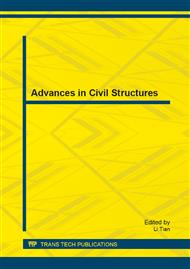p.46
p.50
p.55
p.61
p.67
p.75
p.80
p.85
p.90
Method for Evaluating the Flexural Stiffness Bar of Reinforced Concrete Structures
Abstract:
The structural design methods development nowadays allows including the effects of geometric and mechanical nonlinearity of the materials in the analysis itself. The resolution through matrixes methods frequently involves an incremental treatment for load application and a tangent stiffness matrix that bears in mind the nonlinearity. The present paper shows a procedure to evaluate the bar stiffness considering mechanical nonlinearity of materials. For structures of reinforced concrete formed by two materials where each of them has a resistant behavior so different from the other, its appropriated evaluation is, at the same time, necessary and especially complex. The iterative process exposed here provides the equilibrium position of the section to the general case of axial force and biaxial bending taking into account the nonlinear constituent relationships of materials. Once the equilibrium is reached, the relationship between the biaxial moment and the curvature allows the section stiffness module to be derived, from which the bar stiffness will be determined. As an application of the exposed procedure, the iterative process of the equilibrium research in a section of reinforced concrete is showed. At the moment-curvature diagram can be observed the stiffness progressive decreasing as biaxial bending moments are increasing, because of materials nonlinearity stresses and strains and the section inertia reduction produced by concrete cracking.
Info:
Periodical:
Pages:
67-74
Citation:
Online since:
August 2013
Authors:
Price:
Сopyright:
© 2013 Trans Tech Publications Ltd. All Rights Reserved
Share:
Citation:


